The German Kitchen offers many different regional cooking styles and culinary specialties. Traditional food and drinks are taken care of as well as new creations and variations.
Foreign kitchens have increasingly found their way into Germany since the 1950s and mixed with local dishes. There is hardly a place with gastronomy that does not have Turkish, Greek, Italian or other international restaurants. The global fast food chains are also widespread, and the slow food trend is also gaining ground. Since the beginning of the 21st century, there has also been a trend towards lighter kitchens. Crossover kitchen or Fusion food are becoming fashionable and vegetarian or vegan dishes are also finding their way onto the menus.
According to the Michelin Guide and other gastro guides, top gastronomy in Germany has achieved a high global status. In the 2015 edition, 282 restaurants nationwide were awarded one or more stars, the third most in the world after Japan and France.
Regional cuisines
In all regions of Germany there is still local, rooted cuisine, based on traditional recipes with local products. These dishes are often easier to find in the country than in the city. Often the menus of several restaurants have to be compared in order to get typical dishes, but the effort is worth it. Germany tastes different everywhere, a wonderful variety of flavors. Further information can be found in the relevant regional local or area articles.
More articles on the topic:
- Beer in Bavaria, Breweries in Franconia, Breweries in Bavaria, Distilleries in Franconia
- Eating and drinking in old Bavaria
- Eating and drinking in Baden-Württemberg
- Eating and drinking in Berlin
- Eating and drinking in Brandenburg
- Eating and drinking in Franconia
- Eating and drinking in Hessen
- Eating and drinking in Mecklenburg-Western Pomerania
- Eating and drinking in Lower Saxony
- Eating and drinking in East Frisia
- Eating and drinking in the Rhineland
- Eating and drinking in Saxony
- Eating and drinking in Saxony-Anhalt
- Eating and drinking in Schleswig-Holstein
- Eating and drinking in Thuringia
- Eating and drinking in Westphalia
- Small dinner tour in Berlin and Brandenburg
Records
- The community Aufseß is known for its brewery density and received an entry in the Guinness Book of Records 2001. There are 1,317 inhabitants compared to 4 breweries, with 330 inhabitants per brewery, the highest density of breweries in the world.
- Baiersbronn is the only German community with 8 stars after Guide Michelin and also the only one with two 3-star restaurants.
- The strongest beer in the world with 57.5% is currently from the small brewery Oberasbacher Schorschbräu near by Gunzenhausen brewed. The bock beer is cooled down and the resulting ice crystals are separated, leaving beer with a higher alcohol content.
- The highest restaurant in Germany is on the Zugspitze at 2600 meters above sea level.
- The Berggasthof Ahornkaser at Berchtesgaden is the highest mountain inn in Germany that can be reached by car at over 1520 m above sea level. NN.
Meat dishes
schnitzel
Pork schnitzel with french fries or potato salad are on the menu in all parts of Germany. As a German standard dish, it is well suited to determine the price level of the individual restaurant or the area. The prices vary between € 5 and € 20. Some of the best-known variants are listed below, but the variety of schnitzel variations in Germany is indescribable, you can find a new taste experience every day, many menus offer surprises.
- A schnitzel is not so often found on the menu, it is made from veal and is accordingly more expensive. Usually it is cheaper Wiener Schnitzel made from pork.
Schnitzel Viennese style with potato salad

Cordon Bleu
- Hunter schnitzel is usually a fried pork schnitzel, more rarely veal with a mushroom-tomato or mushroom-cream sauce. In some areas it is breaded, in others not, which is called natural schnitzel. Another variant that originated in the GDR and can still be found today in the new federal states, one centimeter thick slices of hunting sausage or beer ham are breaded and served with a sauce made from tomatoes with onions. Served as a side dish are potatoes, potato salad, mashed potatoes, French fries, croquettes or noodles.
Jägerschnitzel with mushroom sauce and French fries
Breaded hunting sausage with mashed potatoes and mixed vegetables
.jpg/150px-DDR-museets_restaurant_(5846161802).jpg)
Jägerschnitzel DDR with tomato sauce and spiral noodles
- Berlin schnitzel - not a real schnitzel, but breaded cow udder
- Cordon Bleu is a breaded schnitzel filled with cheese and ham
- Schnitzel Alsatian style - with bacon, onions and crème fraîche
- Hamburger schnitzel - with fried egg, partly with fried onions
- Hawaii schnitzel - Baked with pineapple and cheese
- Schnitzel Holstein, also à la Holstein - Veal schnitzel with fried egg, smoked salmon, oil sardines, capers, anchovy fillets with fried potatoes, beetroot and pickles

Holstein schnitzel with fried eggs

Parisian schnitzel with fries
- Children's schnitzel - smaller portion with french fries and ketchup, mostly with funny names on the menu
- Cooked cheese schnitzel - Breaded pork schnitzel with cooked cheese, often served with pickled onions and farmer's bread
- Munich schnitzel - Schnitzel Wiener Art coated with sweet mustard and horseradish under the breading.
- Parisian schnitzel - Thin veal schnitzel, salted, turned in flour and beaten egg and fried
- Turkey schnitzel - plain or breaded, from the turkey
- Swiss schnitzel - breaded and baked with cheese
- Schnitzel Spreewald style - Breaded pork schnitzel, coated with horseradish after roasting, topped with pickles and baked with cheese
- Gypsy schnitzel - plain or breaded with a paprika sauce
Turkey schnitzel breaded with spaetzle
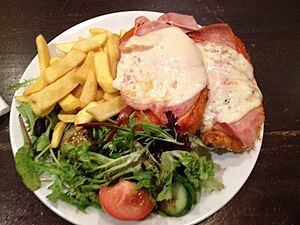
Swiss schnitzel
Gypsy schnitzel
Pork legs
Parts of the pig's leg are popular in all parts of Germany. They are offered boiled, fried, grilled and breaded, and there are also many options for side dishes. There are many names for it: Knuckle of pork, Shank, Lizard, Knuckle, reel, stilt, in the Rhineland Hammche, Bötel, in francs Ankle, in Bavaria Pork knuckle

Cured pork knuckle, cooked, with sauerkraut

Kombes with pork knuckle and mashed potatoes

Grilled knuckle
Pork knuckle with dumplings
Breaded knuckle of pepper with pepper sauce and dumplings
Roulade
The Roulade is a typical German dish. Thin slices of meat are rolled around a piece of bacon and pickles, seasoned with onions, mustard, pepper and salt. The meat is fried quickly and then slowly cooked for an hour. The roulade is served with red cabbage and, depending on the region, with boiled potatoes, mashed potatoes, spaetzle, dumplings or dumplings. Roulades are prepared with veal, turkey, beef or pork.
Are a specialty cabbage rolls or Cabbage wrap, blanched savoy cabbage or white cabbage leaves are coated with meat mixture and then wrapped.

Beef roulade with apple red cabbage and potato dumplings

Beef roulade with spiral noodles and gravy
Cabbage wrap with potato salad
Sauerbraten
A Sauerbraten is a traditional sweet and sour pot roast with different regional variations. Raw meat, mostly beef, is pretreated by soaking it in a vinegar marinade for several days. The sour pickling was used in earlier times to protect meat from spoilage. The meat is then seared, poured on with diluted marinade and stewed for several hours. Then it is sweetened to get the typical sweet and sour taste of the sauce and thickened with sauce gingerbread. The piece of meat is cut into slices for serving and served with potato dumplings, boiled potatoes or noodles, with red cabbage as a side dish. There are two main types of sauerbraten, with an emphasis on angry is cooked in Franconia, Saxony and Swabian, while the Rhenish rather direction sweet goes.
At the known Rhenish sauerbraten horse meat was also used in the past, which is hard to find nowadays. Raisins are often added to the sauce, more rarely baked fruit.

Marinated beef for sauerbraten
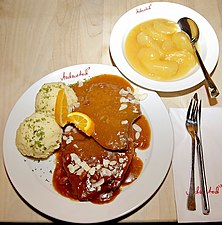
Rhenish sauerbraten from the horse in raisin sauce with dumplings and applesauce

Saxon sauerbraten with potato dumplings and red cabbage
Franconian sauerbraten with sauce gingerbread
More dishes
- Meatballs are a former East Prussian specialty that is now well known throughout Germany and can be found on many menus. It will also Caper dumplings, Sour balls, Dumplings or Cooking knobs called. The meatballs consist of minced beef or veal mixed with minced pork, chopped anchovies, onions, soaked white bread, eggs and spices. They are cooked in salted water, possibly with a dash of white wine or vinegar and spices. The broth is sifted, bound with light roux, cream and egg yolk and refined with lemon juice and capers. The dumplings are served with boiled potatoes, boiled potatoes or mashed potatoes.
- As Herring dumplings they are called if salted herring was used instead of anchovies.
- At Kasseler Ribs, chops, comb, shoulder, belly, etc. are cured and lightly smoked pieces of pork. The name has nothing to do with the city kassel to do as one might think. There are various theories about where the name came from. The pork ribs get their name from the Hebrew (cashier or Yiddish chaser means pig. Another theory is that Kasseler comes from Kasserolle and may have been introduced with the Huguenots. According to a third theory, the term comes from a Berlin butcher named Cassel. Kassler pork is eaten all over Germany.

Königsberger Klopse with boiled potato
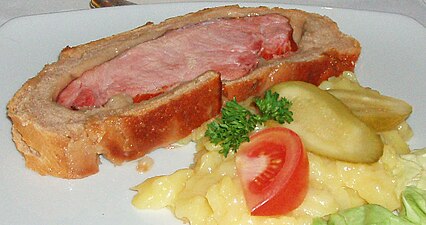
Kassler in bread dough with potato salad
Fish dishes
All common sea fish from all seas and whatever else is brought in from the international fish trade are offered in restaurants. Pangasius is on many menus because of its low price. Typical types of fish for the North and Baltic Sea coasts are herring, cod, cod, mackerel and the flatfish flounder, turbot and plaice.
.jpg/259px-Krabbenbrot_01_(RaBoe).jpg)
Crab bread

Green herrings with fried potatoes

Plaice with potato salad
As freshwater fish, char, pikeperch, catfish and trout are on the menus all over Germany. The carp is very popular in Franconia from September to April. Black whitefish are offered on the Bavarian lakes and whitefish on Lake Constance. This is a fish (coregonus) from the salmon family, which is usually served smoked or fried. The same species of fish is known as vendace on the Mecklenburg lakes.
baked carp
Trout miller
They are known Crabs on the North Sea coast, there they will garnet called, which you can peel yourself or buy already peeled.
- A rollmops. is a herring cloth pickled in vinegar and salt, which is eaten rolled up and filled with pickles. It is held together by two small wooden sticks that prevent premature unrolling. It is said to have originated in Berlin in the first half of the 19th century.
- Bismarck herring are herring cloths that are marinated in a sour marinade made from vinegar, cooking oil, onions, mustard seeds and bay leaves. They are traditionally served with fried potatoes or with onions and pickles on a bun as Bismarck rolls eaten.
- Fried herring are fried and then marinated herrings. They are eaten with bread, fried potatoes or jacket potatoes.
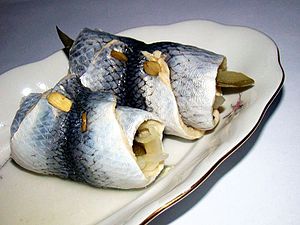
rollmops

Bismarck rolls
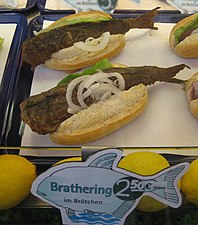
Fried herring with onion rings in a bun
- Salmon substitute is cold-smoked pollock (coalfish) or Alaska pollock (Pacific pollack), which is colored in such a way that the color is reminiscent of salmon. The fish fillets are sold commercially as slices or saithe schnitzel. The salmon substitute is often available as a salmon roll with onion rings and cucumber slices on a light-colored roll.
- Kiel sprats are a fish specialty Schleswig-Holstein. Sprats, a herring-like sea fish, around 10 cm long are used, which are smoked over beech and alder wood. Some eat them whole, without exception, head and tail. Usually, however, the head is cut off before eating and the tail with the main bone is carefully pulled out.
Salmon substitute rolls
Kiel sprats

Stint
The smelt (Latin Osmerus eperlanus) belongs to the same family as salmon and sea trout. Like its big siblings, the smelt moves up the Elbe for a couple of weeks from late February to April, depending on the water temperature, during spawning time, a festival for fish lovers. The fish is usually 15 to 18, a maximum of 30 centimeters long. Connoisseurs know that the smelt only tastes good if it is not older than a day, you should be able to tell with your nose, it has a slight cucumber scent.
The fish are gutted and the head removed. Before roasting, they are salted and then turned in rye flour. The smelt is traditionally eaten with warm bacon and potato salad. During the smelt season, the specialty is in restaurants on the Elbe in Lower Saxony from the mouth up over Hamburg until about Luneburg offered.
Vegetarian and meatless dishes
You can now find meat-free or vegetarian dishes on almost every menu. With vegan dishes you have to search a little longer.
- Dumpling with sauce available in Bavaria as a meatless dish in inns where dumplings are on the menu. If it's not on the menu, just ask for it, usually it's not a problem. There is a gravy with the dumpling, which you can often choose. Not suitable for vegetarians and vegans as it is a sauce made with meat. Muslims can ask for beef or chicken sauce.
- cheese noodles are in the south of Baden-Wuerttemberg and a popular dish in parts of Bavaria. It is pasta with cheese and fried onions.
- Become common Vegetables baked with cheese or Vegetables with bechamel sauce offered as a vegetarian dish. The composition of the vegetables varies depending on the restaurant and the season.

cheese noodles
Vegetables baked with cheese
Vegan food
In classic home-style restaurants, vegans often only have a side salad with a dry slice of bread.
In restaurants with foreign cuisines, Mediterranean, Asian, etc., it is often easier to find vegan dishes on the menu.
Times are changing, however, and vegan restaurants can now be found more often in larger cities. These often only offer vegan dishes, which requires non-vegans to be willing to compromise in order to eat together.
As a vegan, you should research beforehand if possible. Talking to the staff is also a way, often there are possibilities.

A rare exception - vegan sausages with sauerkraut and fried potatoes
Side dishes
Cabbage
sauerkraut is white cabbage or pointed cabbage preserved by lactic acid fermentation, which is usually eaten cooked as an accompaniment to meat dishes. Sauerkraut is internationally recognized as a typical German dish, but is also very popular with the eastern neighbors and in Alsace.
Franconian sausages with sauerkraut

Kasseler and sauerkraut
In the German-speaking area, in the south, herb, in the north rather from Cabbage spoken. In North Rhine-Westphalia and the Rhineland one speaks of Capes,
Red cabbage is used in northern Germany, Red cabbage in central and southwest Germany and Red cabbage used in southern Germany and spoken of red / blue caps in North Rhine-Westphalia and Rhineland.
Beef goulash, red cabbage and Thuringian dumplings
Rabbits, dumplings and red cabbage
Beef roulade with red cabbage and bread and potato dumplings
Kale or Brown cabbagelike him in Braunschweig, Hanover, the Magdeburg Börde and Bremen is a typical winter vegetable from Northern Germany. It is largely unknown in the south. In many parts of Lower Saxony and Schleswig-Holstein, it is a real cult to go on a cabbage ride with clubs, companies and other groups in the autumn and winter months. A typical dish is cabbage with Pee, a smoked grützwurst.

Kale with pee, boiled sausage, smoked pork and bacon

Kale with pee
Knee pork cabbage is in the Prignitz National dish. It is a sour vegetable similar to sauerkraut. It consists of white cabbage, blue marrow stem cabbage, or leaves of red cabbage, kale and cherry and vine leaves. The cabbage leaves are boiled, squeezed out, salted in, pounded into stoneware pots in layers with the vine and cherry leaves and then fermented lactic acid for a few weeks. The Knieperkohl is served with pork knuckle, cabbage sausage, Knacker or Kasslerkamm, with potatoes.

Knieperkohl with smoked pork, cabbage sausage and potatoes
Potatoes
Potatoes are a popular and very diverse side dish in Germany. French fries, boiled potatoes, boiled potatoes and fried potatoes are popular everywhere.
fried potatoes
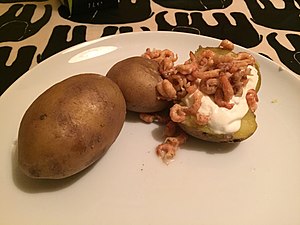
Jacket potatoes with shrimp and sour cream

Salt potatoes
In the south, especially in Thuringia and Franconia, people like to eat potato dumplings for frying. In Saarland, people like them filled and unfilled.
Thuringian dumplings
Franconian dumplings
.jpg/260px-UngefüllteKartoffelklößeL1160714_(3).jpg)
Unfilled and

filled in Saarland
When it comes to potato salad, the land is divided, in the north with mayonnaise, in the south with a marinade of vinegar, oil and broth, preferably with cucumber.
Potato salad with mayonnaise

Potato salad without, but with bacon
loaf
The whole world loves white bread, not so Germany, here the breads are darker and firmer. There is an incredible variety, well over 300 varieties are baked across the country. It is not uncommon for bakeries to have more than twenty different types of bread. Many different types of grain such as wheat, spelled, rye, etc. are used and varied with pumpkin or sunflower seeds. Wholemeal bread made from whole grains or specialties such as pumpernickel, a bread that is baked in steam chambers for 24 hours.

The agony of choice
In rural areas, people often still bake together in the wood oven
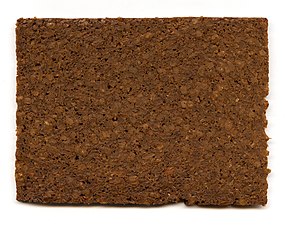
A slice of pumpernickel
bun

There are a multitude of names from north to south, the number of variations is vast. It's worth going to a bakery in each area and trying new varieties. Often the local names are added, e.g. sesame, multigrain, rye rolls.
- bun is mainly used in Lower Saxony, Mecklenburg-Western Pomerania, North Rhine-Westphalia, northern Rhineland-Palatinate, large parts of Hesse, northern Saxony-Anhalt and parts of Brandenburg. This term is also understood in the rest of Germany.
- In Thuringia, in southern Saxony-Anhalt and in Saxony bun and Bread roll used.
- Round piece are used in Schleswig-Holstein, Hamburg and parts of north-western Lower Saxony
- Bread roll is understood throughout Bavaria and southern Thuringia
- Wake-up (-en / -e / -a), or Weck (-le / -li / -la) are mainly used in Baden-Württemberg, Rheinhessen, South Hesse, the Palatinate, and Saarland. Designate in francs Weggla a milk roll;
- Schrippe is common mainly in Berlin and Brandenburg, but also in Hamburg, Schleswig-Holstein and Mecklenburg-Western Pomerania.
- Bommel is the name on Hiddensee Mecklenburg-Western Pomerania
- Kipf (-l / -la / -le), Laabla , Stella/Stolle, Wegg (-la / -li) they say in Franconia
- Stüütkes hot rolls in Platt in western Lower Saxony
snack
- Fish rolls are omnipresent in the north of the republic and on the coasts, as bismarck, matjes, salmon, fish buns, smoked fish rolls or something else. The prices are between € 2 and € 3, depending on the version.
- Sausages is available all over Germany with a multitude of sausage variations. They are particularly popular in Franconia and Thuringia.
.jpg/420px-Fischbroetchen_01_(fcm).jpg)
Fish rolls with Bismarck herring with onions and pickled cucumber slices
Thuringian sausage

Franconian bratwurst
- Currywurst is a sausage with a sauce based on ketchup or tomato paste and curry powder. The usual side dishes are rolls or French fries. Herta Heuwer is considered the inventor in 1949 in Berlin-Charlottenburg. The sausage is now available nationwide, but Berlin and the Ruhr area are considered strongholds.
- 1 Konnopkes snack is located in Berlin / Prenzlauer Berg at Eberswalder Strasse underground station under the viaduct of the elevated railway. It is open Monday through Friday between 10 a.m. and 8 p.m.
- Doner kebab was made popular by immigrants of Turkish origin. There shouldn't be a pedestrian zone in Germany where you can't get a kebab. The usual variant is flatbread quartered and sliced, filled with lamb or veal (and up to 60% minced meat) from the rotisserie (Turkish doner = to turn), supplemented with a side salad made of lettuce, tomatoes, cucumber, onions, white and Red cabbage, sheep cheese and pepperoni and sauces with mayonnaise and yogurt. As a plate dish, doner kebab is served with rice and salad or with french fries.
- There is no sandwich tradition in Germany, but they have been used in bakeries, butchers and kiosks for decades sandwich which are serious competition for the fast food chains. They are more varied and lovingly filled and you can often taste the regional specialties. In almost every butcher's shop you can get a roll with sausage or, in Bavaria, with Leberkäse, if necessary on request.

Currywurst with french fries red / white
.jpg/336px-Donner_Kebab,_Cologne,_Germany_(1057919169).jpg)
Doner kebab in flatbread

Leberkäsesemmel
- Hawaiian toast. or Toast Hawaii is a toast that is topped with ham, pineapple and gratinated with cheese. It was invented in the 1950s and very popular in West Germany. Even today it is still eaten with pleasure and you can find it again and again on menus.
- Tighter max. is a simple dish that is often offered in pubs. The basic equipment is a slice of bread, mostly toasted, with boiled ham, raw or fried, and a fried egg on top. There are a multitude of flavors, with cheese, onions, pickles, and more. In the south, ham is often replaced by meat loaf.

Toast Hawaii

Tighter max
Street food
In Germany, too, the number of food trucks is increasing and the food that deviates from the usual snack is becoming more and more popular. Under foodtrucksdeutschland.de gives an overview of what is culinary on the streets of Germany. The dishes on offer are creative and the quality of the food is high. This will be several times a year Franconian Food Truck Roundup held in Nuremberg, a meeting of food trucks from all over Germany and Austria. The food trucks are usually parked from Monday to Friday at different locations in the greater Nuremberg area and often at events on the weekend; details about the locations are available on the respective homepage. There is also an app for food trucks throughout Germany.
Food truck
Sweets
- Red fruit jelly is a dessert that is served with lightly whipped cream or with vanilla sauce. Various red fruits are bound with the addition of sugar and some fruit juice with cornstarch.
- Spaghetti ice was invented in Mannheim in 1969. Vanilla ice cream is pressed through a spaetzle press, which creates the spaghetti-like shape, topped with strawberry sauce as tomato sauce and grated white chocolate as grated cheese.
- Black Forest cake is a classic German cake that is known all over the world. It usually consists of chocolate sponge cake bases flavored with kirsch, cherry filling, cream, cherries and chocolate flakes as a decoration.

Red fruit jelly with cream

Spaghetti ice
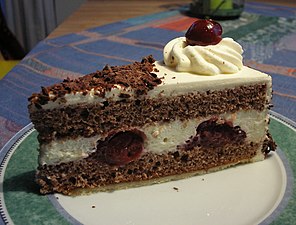
Black Forest cake
- Berlin pancakes, Donuts, pancakes, donuts, carnival donuts, there are many names for the pastries. It is about the size of a fist, made from yeast dough balls, which are fried in fat and then filled. The fillings vary greatly from region to region. Red strawberry or cherry jam is preferred in the north and in the Rhineland, apricot jam in Bavaria, rose hip pulp in Swabia, Baden and Franconia, and plum jam in eastern Germany. Newer creations also use vanilla cream, nougat, whipped cream or eggnog as a filling. There are Berliners covered with icing, fat glaze or powdered sugar. Traditionally, the donuts are eaten on New Year's Eve and during Carnival, and they are available all year round.

traditionally filled and sprinkled with sugar

modern variants
- dominoes are a gingerbread specialty that are available all year round, but actually belong to Christmas cookies. The cubes are made up of several layers, brown gingerbread and fillings such as marzipan, persipan and fruit jelly and then coated with chocolate on the outside. They were developed by the Dresden chocolatier Herbert Wendler in 1936, during the Second World War they were used as Emergency chocolate popular.
- rum balls (Punch ball, truffle) is a round confection made from fat, sugar, nuts or almonds, chocolate and cocoa, rolled in chocolate sprinkles. As the name suggests, they are mostly made with rum, but only with a rum flavor.

Dominoes come in many varieties
in the usual packaging
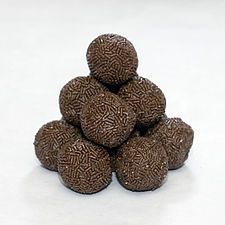
rum balls
sheet cake
- This is a classic of German cuisine Bee sting. A yeast dough is rolled out thinly on a baking sheet and coated with a vanilla, cream or fat cream. On top is a mixture of fat, sugar and almonds, which caramelises during baking and forms a tight lid.
- At the crumble cacke the topping of streusel is the decisive factor. The crumbs that cover the filling are made from sugar, fat and flour. The base of the cake is a thin yeast dough, on top of which is the filling and on top of it the crumble. There are no limits to the fillings, from apples, plums and rhubarb to poppy seeds - everything is possible.

Bee sting

crumble cacke
ingredients
- Kohlrabi is considered a typical German vegetable. The German name has even been adopted in other languages, including English, Russian and Japanese. Kohlrabi is versatile, it is eaten raw e.g. B. in a salad, steamed as a side dish, or as a main ingredient, e.g. as a vegetarian schnitzel. It can be found in many soups, stews, and vegetable dishes.
.jpg/233px-Koolrabi_(Brassica_oleracea_convar._acephala_alef._var._gongylodes).jpg)
Kohlrabi in the field
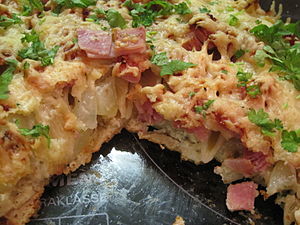
Casserole with kohlrabi and ham
Kohlrabi as a side dish
- As Green kernels is the name given to the grain of spelled that is harvested half-ripe and then artificially dried. In the past, this procedure was a measure to react to bad weather and to save the harvest. The result turned out to be tasty when boiled in water and is therefore often used for soups. During the drying process, the green spelled gets its typical taste from the development of heat and beech wood smoke. As the “home of the green core” Building land denotes where today many villages still have green spelled kilns. The "Fränkische Grünkern" produced in the building land is protected as a designation of origin throughout Europe.
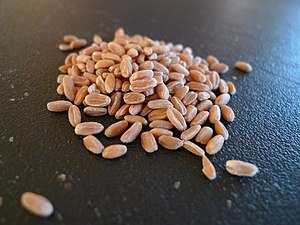
Green kernels
Drying pan for drying green spelled in Sindolsheim
beverages
beer
see alsoBeer in Bavaria, Beer cellar in Franconia
If you just order a beer in the southern parts of the country you usually get a 0.4 liter glass. There are deviations in Bavaria, where you often get 0.5 liters. If you order a Maß, there is a liter. In the north (depending on the division north of the Harz or north of the Main) you are often asked whether you want a "big" or a "small" beer. Large means 0.4 liters, small between 0.2 and 0.3 liters. In the Rhineland around Cologne and Düsseldorf, beer glasses are smaller, usually 0.2 liters.
Beer tastes in Germany are different. In the north people drink Pils, in the Rhineland Kölsch or Alt, in the east black beer, in the south wheat beer, in Franconia lager and around Munich light beer. There are also a variety of other types of beer and local flavors.
Measure - 1 liter

Wheat beer glass - 0.5 liters
Beer mug - 0.5 liters

Pilstulpe - 0.2-0.4 liters
Kölsch bar - 0.2 liters
Wine

There are 13 different wine-growing areas in Germany, and the location of the wine-growing areas can be seen on the map.
- The wine region Ahr is the largest closed wine-growing region for red wine with 84.7% red wine and 15.3% white wine.
- Swimming is the southernmost wine-growing region and is the only one belonging to the European Union's wine-growing zone B, such as Alsace, Champagne and the Loire Valley. The most important grape variety is the Pinot Noir.
- In Francs Wine is mainly grown in the valleys of the Main, Wern, Franconian Saale and Tauber. Mainly white wine is grown, the main grape varieties are Silvaner, Riesling and Müller-Thurgau.
- The Mountain road lies on the western edge of the Odenwaldes. It is divided into Hessian mountain road and Badische Bergstrasse
- The area Middle Rhine extends from the mouth of the Nahe Bingen until Siebengebirge at Bonn.
- Moselle refers to a wine-growing region in the Moselle valley with the side valleys of Saar and Ruwer
- The wine region Near extends from the mouth of the Nahe to shortly before Kirn, with the center Bad Kreuznach and is best known for its Rieslings.
- The wine region Palatinate is the second largest German wine-growing region with around 6,800 wineries.
- The Rheingau is to the west of the knee of the Rhine Wiesbaden. Mainly the Riesling grape variety is grown.
- In Rheinhessen 20% of the area is planted with vines, which is why it is the least forested area in Germany. It is also the largest wine-growing region in Germany, with over 6,000 winemakers producing more than 250 million liters of wine per year. In Nierstein is the oldest documented (742) vineyard in Germany, the Niersteiner Bell.
- The area Saale-Unstrut extends on the Saale from Jena to Burgwerben near Weißenfels and on the Unstrut from Laucha to the confluence with the Saale near Naumburg. Durch die nördliche Lage gedeihen vor allem frühreifende Sorten wie Müller-Thurgau, Weißburgunder und Silvaner.
- Das Weinbaugebiet Saxony ist das nördlichste in Deutschland und liegt fast ausschließlich im Raum Dresden. Nur in diesem Gebiet wird der Goldriesling angebaut.
- Württemberg ist berühmt für seine Rotweinlagen. Die häufigsten Rebsorten sind (rot) Trollinger, Blauer Portugieser und Dornfelder, (weiß) Riesling, Silvaner, Kerner und Müller-Thurgau.

Qualitätsstufen
Nach dem deutschen Weingesetz gibt es vier Güteklassen (nach steigender Qualität sortiert):
- Wine, früher hieß er Tafelwein
- Landwein
- Qualitätswein bestimmter Anbaugebiete (QbA)
- Prädikatswein, Qualitätswein mit Prädikat (QmP). Diese Stufe unterteilt sich nochmals nach dem Mostgewicht in Grad Öchsle (Dichte des unvergorenen Fruchtsaftes, Anteil der gelösten Stoffe, hauptsächlich Zucker). Die Weine werden mit jeder Stufe süßer und teurer.
- Kabinett, das Mostgewicht liegt bei 67 bis 83 Grad Öchsle
- Spätlese: aus Trauben, die nach der Hauptlese geerntet wurden mit 76° bis 90° Öchsle.
- Auslese, beschädigte, kranke oder unreife Beeren werden ausgesondert, mit 83° bis 95° Öchsle, Rotwein bis 100° Öchsle.
- Beerenauslese, überreife und edelfaule Trauben, einzeln verlesen, mit 110 bis 128° Öchsle.
- Trockenbeerenauslese, edelfaule Trauben mit 150° bis 154° Öchsle.
- Eine Besonderheit ist der Eiswein, die Beeren müssen bei der Lese gefroren sein, sie findet bei -6 °C oder kälter statt. Das Wasser gefriert und kommt beim Pressen der Trauben nicht in den Most. Der Saft ist konzentriert mit 110 bis 128° Öchsle.
Süßegrade
- Trocken nennt man einen Wein mit einem Restzuckergehalt von maximal 9 g/l. Klassisch trocken erlaubt nur 4 g/l, mit weniger als 2 g/l darf auf dem Etikett stehen: Für Diabetiker geeignet
- Halbtrocken ist ein Wein mit 9 bis 18 g/l unvergorenem Zucker
- Lieblich, Halbsüß heißt er ab 18 g/l bis zu 45 g/l .
- Süß ist er bei einem Restzuckergehalt von mehr als 45 g/l.
Weinetikett
Auf dem Weinetikett müssen folgende Angaben vorhanden sein: Qualitätsstufe, Geografische Herkunft, Abfüller, Alkoholgehalt, Nennvolumen, Weinart, enthält Sulfite. Nachfolgende Angaben dürfen angegeben sein: Jahrgang, Rebsorte, Geschmacksangabe, Weinort und Lage und zusätzliche Angaben wie Trinktemperaturen und Speiseempfehlungen.
Sekt
Gäste aus dem Ausland werden sich wundern, warum Sekt in Deutschland so teuer ist. Dies liegt an der Schaumweinsteuer, die 1902 vom Reichstag zur Finanzierung der kaiserlichen Kriegsflotte eingeführt wurde und bis heute dem Staat gute Einnahmen bringt. Derzeit (2021) beträgt sie für Schaumweine ab 6 Volumenprozent Alkohol 1,02 € pro 0,75 l Flasche.
Mischgetränke
- Bei der süßen Schorle wird Wein mit Zitronenlimonade gemischt, bei der sauren Schorle mit Mineralwasser.
- Bier mit Zitronenlimonade gemischt wird im Süden Radler genannt, im Norden Alsterwasser. In Ostdeutschland trifft man oft eine Abwandlung, bei der statt Zitronenlimonade, rote Himbeerbrause verwendet wird. Dieses Mischgetränk ist als Potsdamer bekannt.
- Spezi ist ein Mischgetränk aus Cola und Orangenlimonade.
Essen gehen
- Anders als in anderen Ländern kann man in Deutschland mit sehr wenigen Ausnahmen seinen Tisch im Restaurant frei wählen. In manchen American Diners und in der gehobenen Gastronomie gehört es zum Flair, dass man sich einen Platz zuweisen lässt. Es ist jedoch problemlos möglich, beim Betreten eines Lokals die Bedienung nach einem freien Tisch zu fragen, um die eigene Suche zu verkürzen.
- Steht auf dem Tisch ein Schild mit der Aufschrift Reserviert, so sollte man sich nicht an diesen Tisch setzten, da er bereits für andere Gäste reserviert ist. In vielen Restaurants steht noch eine Uhrzeit auf der Reservierung, dann kann man abschätzen, ob die Zeit noch reicht um etwas zu essen oder trinken, bis die anderen Gäste kommen.
- Üblicherweise wird mit Messer, Gabel und Löffel gegessen, Ausnahmen gibt es nur am Imbiss, in Fastfood Restaurants und bei Geflügelgerichten. Wenn man dem Personal anzeigen möchte, dass man mit dem Essen fertig ist und abgeräumt werden kann, legt man Messer und Gabel parallel schräg auf den Teller, etwa in der Stellung 11.00 Uhr vormittags - 5.00 Uhr nachmittags.
- Es ist in Deutschland nichts Ungewöhnliches, wenn alle an einem Tisch einzeln zahlen und der Ober mehrere Rechnungen ausstellen muss.
- In den letzten Jahren wird es immer häufiger, dass man sich größere Essensreste für zu Hause einpacken lässt. Einfach die Bedienung danach fragen, meist bietet sie freundlich eine Lösung an.
- Eine feste Regel für das Trinkgeld gibt es in Deutschland nicht, auf die amerikanischen 10 % bis 15 % der Rechnungssumme muss man auch nicht gehen, aber irgendetwas zwischen 5 % und 10 % sollte es schon sein, wenn man mit Essen und Service zufrieden war. Wenn man nicht zufrieden war, ist es auch kein Problem nichts zu geben. Häufig wird einfach aufgerundet, z.B. von 9,20 auf 10, von 47,80 auf 50. Dann gibt die Bedienung auf den genannten Betrag heraus und hat ein Trinkgeld.
- Speisekarten sind nach dem Gesetz entweder auf Tischen auszulegen oder dem Gast vor der Bestellung vorzulegen oder gut lesbar anzubringen. Die angegebenen Preise müssen Bedienungsgeld, Steuern und sonstige Zuschläge beinhalten. Gesonderte Zuschläge, z.B. für Musik, oder für das Gedeck sind nicht zulässig. Mindestens eine Speisekarte mit einer aussagekräftigen Auswahl an Speisen- und Getränkepreisen ist gut sichtbar neben dem Eingang auszuhängen.
- Es ist in Deutschland Vorschrift, Zusatzstoffe im Essen zu benennen. Es stehen auf den Speisekarten hinter den Gerichten häufig kleine Zahlen und auf der Seite unten, oder auf der letzten Seite der Karte findet man die Fußnote mit den Zusatzstoffen. Ausgewiesen werden Farbstoffe, Konservierungsmittel, Geschmacksverstärker usw. Wenige Zusätze weisen darauf hin dass alles aus frischen Zutaten zubereitet wurde, viele Zusätze können ein Hinweis auf Convenience sein, dass das fertig gekochte Gericht nur aufgewärmt wurde.
- Eichstrich ist eine Kennzeichnung auf Schankgefäßen (Limogläsern, Biergläsern, Schnapsgläsern, Weingläsern und Weinkaraffen im gewerblichen Ausschank). Es muss das Volumen als Zahlenwert mit Maßeinheit genannt sein. So kann der Gast prüfen, wie viel eingeschenkt wurde.
20 nach vier, es kann abgeräumt werden

Reserviert
.jpg/338px-Eichstrich_am_Glas_(fcm).jpg)
Eichstrich
Restaurantketten
.jpg/250px-Nordsee_L1020264_(4008044726).jpg)
Außer den internationalen Fastfoodketten, die jeder kennt, gibt es auch Restaurantketten, die ihren Ursprung und ihren Niederlassungsschwerpunkt in Deutschland haben.
- Block House betreibt mehr als 42 Steak Restaurants. Die Marke Jim Block ist eine Burgerkette mit der Besonderheit, dass die Burger vor den Gästen zubereitet werden.
- Cafe Del Sol ist eine Restaurantkette mit Bar die ein südländisch-mediterranes Ambiente anbieten. Im Restaurant wird mit überschaubarer Speisekarte internationale Küche sowie Pizza und Pasta angeboten, ein zweiter Schwerpunkt ist eine Bar mit Cocktails.
- dean&david bietet nach eigener Aussage gesunde Lebensmittel mit hochwertigen Zutaten für nachhaltigen Konsum, ohne Geschmacksverstärker, tierische Gelatine, Farb- und Konservierungsstoffe. Es gibt Salate, Bowls, Curries, Suppen, Sandwiches und Wraps. Gut für Vegetarier und Veganer geeignet.
- Gosch ist spezialisiert auf Meeresfrüchte wie Brat- und Kochfisch, Hummer, Austern und andere. Es gibt über 12 Betriebe auf Sylt und 26 Betriebe über Deutschland verteilt sowie Restaurants auf den Kreuzfahrtschiffen Mein Schiff
- HANS IM GLÜCK - Burgergrill ist eine Schnellrestaurantkette im Kontrast zu den amerikanischen Ketten, mit hochwertigen Produkten, frisch zubereitet, vegetarischen Burgern, alkoholischen Getränken.
- Kochlöffel Gastronomiekette mit Grill-Hähnchen, Currywurst, verschiedene Burger, Salate und Softdrinks.
- Maredo hat über 50 Restaurants und ist für qualitativ hochwertige Steaks bekannt.
- Nordsee ist eine Schnellrestaurantkette mit dem Schwerpunkt Fisch und Meeresfrüchte mit mehreren hundert Standorten, von der Fußgängerzone bis zur Autobahnraststätte.
- Sausalitos ist eine Restaurant-Kette, die Speisen und Getränke der kalifornisch-mexikanischen Küche (Cal-Mex) anbietet
- L’Osteria ist eine Restaurantkette mit italienischen Küche. Die Pizza hat einen Durchmesser von 45 cm, außerdem gibt es Antipasti, Pasta, Salate, und Desserts.
- In Vapiano-Filialen wird italienisches Fast Food vor den Augen der Kunden zubereitet. Die Kette legt großen Wert auf den Stil ihrer Restaurants, sie werden vom Südtiroler Architekten Matteo Thun designt. Es gibt Antipasti, Pasta, Pizzen Salate und Dolci. Bei den Pastagerichten werden vorportionierte Frischnudeln, 180 g, verschiedener Formen mit diversen Saucen kombiniert.
- Wienerwald ist hauptsächlich in größeren Städten vertreten mit Hühnerprodukten, berühmt ist das Grillhendl und der Werbespruch „Heute bleibt die Küche kalt, wir gehen in den Wienerwald“.
Kulinarischer Kalender

Januar
- The Internationale Grüne Woche, die weltgrößte Messe für Ernährung, Landwirtschaft und Gartenbau findet am Jahresanfang in Berlin statt.
- Karpfen- und Muschel-Saison in Monaten mit „r“
- Grünkohl oder auch Braunkohl, ist ein typisches Wintergemüse aus Norddeutschland, im Süden ist er weitgehend unbekannt. Die traditionellen Grünkohlessen finden ab November bis Gründonnerstag statt. Im vielen Teilen Niedersachsens and Schleswig-Holsteins ist es ein regelrechter Kult, in den Herbst- und Wintermonaten mit Vereinen, Firmen und sonstigen Gruppen auf Kohlfahrt zu gehen. Ein typisches Gericht ist Kohl mit Pinkel, einer geräucherten Grützwurst.
Februar

- Karpfen- und Muschel-Saison in Monaten mit „r“
- Der Stint zieht zur Laichzeit für ein paar Wochen von Ende Februar bis April die Elbe hinauf. Die Fische werden ausgenommen und der Kopf entfernt, gesalzen und dann in Roggenmehl gewendet, gebraten. Und mit warmen Speck-Kartoffelsalat gegessen. Die Spezialität wird an der Elbe von der Mündung hinauf über Hamburg bis etwa Lüneburg angeboten.
- Grünkohl oder auch Braunkohl, ist ein typisches Wintergemüse aus Norddeutschland, im Süden ist er weitgehend unbekannt. Die traditionellen Grünkohlessen finden ab November bis Gründonnerstag statt. Im vielen Teilen Niedersachsens and Schleswig-Holsteins ist es ein regelrechter Kult, in den Herbst- und Wintermonaten mit Vereinen, Firmen und sonstigen Gruppen auf Kohlfahrt zu gehen. Ein typisches Gericht ist Kohl mit Pinkel, einer geräucherten Grützwurst.
März

- Karpfen- und Muschel-Saison in Monaten mit „r“
- Der Stint zieht der Stint zur Laichzeit für ein paar Wochen von Ende Februar bis April die Elbe hinauf. Die Fische werden ausgenommen und der Kopf entfernt, gesalzen und dann in Roggenmehl gewendet, gebraten. Und mit warmen Speck-Kartoffelsalat gegessen. Die Spezialität wird an der Elbe von der Mündung hinauf über Hamburg bis etwa Lüneburg angeboten.
- The Hopfenspargelwochen in the Hallertau finden von Mitte März bis Anfang April statt. Die zarten Wurzeltriebe der Hopfenpflanze werden per Hand geerntet und in der örtlichen Gastronomie als Spezialität angeboten.Nur solange die Sprossen lichtgeschützt unter der Erde heranwachsen, sind sie verwendbar. Das Wachstum ist stark von der Witterung abhängig, deshalb lässt sich die Erntezeit, von etwa drei Wochen, erst kurz vorher festlegen. Wenn die Pflanzentriebe aus der Erde wachsen ist die Ernte beendet.
- Im März und April sind an der Mecklenburgische Ostseeküste, z.B. in Wismar, Warnemünde on Usedom and RügenHeringswochen
- Ab März bis Mitte Mai ist Bärlauch-Saison, er duftet intensiv nach Knoblauch und animiert Köche zu vielen Gerichten.
- Ab März bis Mitte Juni ist Rhabarber-Saison. Er wird gerne als Kompott oder Konfitüre gegessen der Klassiker jedoch ist Rhabarber-Kuchen
April

- The Hopfenspargelwochen in the Hallertau finden von Mitte März bis Anfang April statt. Die zarten Wurzeltriebe der Hopfenpflanze werden per Hand geerntet und in der örtlichen Gastronomie als Spezialität angeboten. Nur solange die Sprossen lichtgeschützt unter der Erde heranwachsen, sind sie verwendbar. Das Wachstum ist stark von der Witterung abhängig, deshalb lässt sich die Erntezeit, von etwa drei Wochen, erst kurz vorher festlegen. Wenn die Pflanzentriebe aus der Erde wachsen ist die Ernte beendet
- Karpfen- und Muschel-Saison in Monaten mit „r“
- Rhabarber-Saison
- Ab März bis Mitte Mai ist Bärlauch-Saison, er duftet intensiv nach Knoblauch und animiert Köche zu vielen Gerichten.
- Der Stint zieht zur Laichzeit für ein paar Wochen von Ende Februar bis April die Elbe hinauf. Die Fische werden ausgenommen und der Kopf entfernt, gesalzen und dann in Roggenmehl gewendet, gebraten. Und mit warmen Speck-Kartoffelsalat gegessen. Die Spezialität wird an der Elbe von der Mündung hinauf über Hamburg bis etwa Lüneburg angeboten.
- The Spargelsaison beginnt je nach Bodentemperatur Anfang bis Mitte April
- Traditionell wird am 23. April der Tag des Bieres gefeiert, denn an diesem Tag im Jahr 1516 wurde das deutsche Reinheitsgebot proklamiert. Es gibt in vielen Orten Veranstaltungen zum Thema Bier (Deutscher Brauer Bund).
- Ende April und im Mai gibt es die Maischolle, sie wird im Nordatlantik oder in der Nordsee gefangen, misst etwa 35 bis 45 cm und hat besonders zartes Fleisch. Sie wird gerne nach Finkenwerder Art mit Speck gereicht
Mai

- Spargel- und Rhabarbersaison
- Ende April und im Mai gibt es die Maischolle, sie wird im Nordatlantik oder in der Nordsee gefangen, misst etwa 35 bis 45 cm und hat besonders zartes Fleisch. Sie wird gerne nach Finkenwerder Art mit Speck gereicht
- Ab März bis Mitte Mai ist Bärlauch-Saison, er duftet intensiv nach Knoblauch und animiert Köche zu vielen Gerichten.
- The Weindorf (ist ein kulinarisches Weinfest) (am Marktplatz in Würzburg.). Geöffnet: Es dauert 10 Tage ab dem letzten Freitag im Mai.
Juni
- The Spargel- und Rhabarbersaison endet am Johannistag, dem 24. Juni,
- Ab Mitte Juni gibt es Matjes, mit Pellkartoffeln oder Schwarzbrot und mit frischen grünen Bohnen garniert.
Juli

- Im Juli/August ist Pfifferlingszeit mit vielen verschiedenen Pfifferlingsgerichten.
- Das weltgrößte Labskaus-Essen findet an einem Samstag Mitte/Ende Juli in Wilhelmshaven statt. Es werden Tausende von Portionen Labskaus verkauft, der Rekord wurde 2005 mit über 10.000 Portionen erreicht.
August
- Im Juli/August ist Pfifferlingszeit mit vielen verschiedenen Pfifferlingsgerichten.
- An einem Wochenende Ende August ist in CoburgKlößmarkt. Alles dreht sich um den Coburger Kloß auch Coburger Rutscher genannt. Es gibt zu den Klößen vielerlei Braten, wie Sauer- und Schweinebraten und Rouladen mit den entsprechenden Soßen
- Im August/September ist Pilzzeit, Steinpilze und andere Wildpilze bereichern die Speisekarte.

September
- Die neue Karpfen- und Muschel-Saison beginnt, der erste Monat mit „r“
- Im August/September ist Pilzzeit, Steinpilze und andere Wildpilze bereichern die Speisekarte.
- Federweißer, Bremser oder Sturm, wie auch immer der gärende Wein in Deutschland genannt wird. Der Ausschank ist auf wenige Wochen im Herbst beschränkt.
Oktober
- Federweißer, Bremser oder Sturm, wie auch immer der gärende Wein in Deutschland genannt wird. Der Ausschank ist auf wenige Wochen im Herbst beschränkt.
- Im Herbst stehen viele Wildgerichte auf den Speisekarten.
- Karpfen- und Muschel-Saison in Monaten mit „r“
- Der Tag der offenen Brennereien und Brauereien ist jedes Jahr rund um das Walberla am dritten Sonntag im Oktober
- In Nürnberg wird die Consumenta veranstaltet, mit vielfältigem Angebot an nationalen und internationalen Spezialitäten und der Chance, so manche Kostprobe zu ergattern.
November

- Im Herbst stehen viele Wildgerichte auf den Speisekarten.
- Um den Martinstag am 11. November herum werden in vielen Gasthäusern Gansgerichte als traditionelles Martinsgansessen angeboten.
- Karpfen- und Muschel-Saison in Monaten mit „r“
- Grünkohl oder auch Braunkohl, ist ein typisches Wintergemüse aus Norddeutschland, im Süden ist er weitgehend unbekannt. Die traditionellen Grünkohlessen finden ab November bis Gründonnerstag statt. Im vielen Teilen Niedersachsens and Schleswig-Holsteins ist es ein regelrechter Kult, in den Herbst- und Wintermonaten mit Vereinen, Firmen und sonstigen Gruppen auf Kohlfahrt zu gehen. Ein typisches Gericht ist Kohl mit Pinkel, einer geräucherten Grützwurst.
- Im November findet das verkaufsoffene Wochenende mummegenussmeile in der Innenstadt von Braunschweig statt. Gastronomen bieten Kreationen rund um die Mumme an und auf einem Markt gibt es Mumme-Produkte zu kaufen.
Dezember

- Die Vorweihnachtszeit ist die Zeit der Weihnachtsmärkte mit Glühwein und Lebkuchen
- Grünkohl oder auch Braunkohl, ist ein typisches Wintergemüse aus Norddeutschland, im Süden ist er weitgehend unbekannt. Die traditionellen Grünkohlessen finden ab November bis Gründonnerstag statt. Im vielen Teilen Niedersachsens and Schleswig-Holsteins ist es ein regelrechter Kult, in den Herbst- und Wintermonaten mit Vereinen, Firmen und sonstigen Gruppen auf Kohlfahrt zu gehen. Ein typisches Gericht ist Kohl mit Pinkel, einer geräucherten Grützwurst.
- Karpfen- und Muschel-Saison in Monaten mit „r“
literature
- Christine Metzger (Hg.): Culinaria Deutschland. Deutsche Spezialitäten. Tandem, Potsdam 2013, 467 Seiten, ISBN 978-3-8427-0684-2 , € 10,00. Wiederauflage eines ursprünglich 1997 in zwei Bänden bzw. 1999 in einem Band bei Könemann (Köln) erschienenen Kochbuches mit vielen Infos zu den deutschen Regionen und deren Küche.





.jpg/150px-DDR-museets_restaurant_(5846161802).jpg)



















.jpg/259px-Krabbenbrot_01_(RaBoe).jpg)


























.jpg/260px-UngefüllteKartoffelklößeL1160714_(3).jpg)






.jpg/420px-Fischbroetchen_01_(fcm).jpg)




.jpg/336px-Donner_Kebab,_Cologne,_Germany_(1057919169).jpg)
















.jpg/233px-Koolrabi_(Brassica_oleracea_convar._acephala_alef._var._gongylodes).jpg)










.jpg/338px-Eichstrich_am_Glas_(fcm).jpg)

